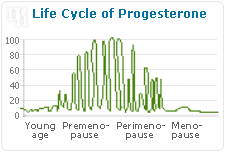As a woman, one of the most complicated things about your body is your hormones: they're in a constant state of fluctuation, influencing and regulating nearly every cell, organ, and function in your body, from the menstrual cycle to mood and libido. Their fluidity makes it difficult to define what "normal hormone levels" really are. While there are no hard and fast rules, there are some general guidelines you can follow to determine whether or not your progesterone levels are too high. Read on to learn more.
Progesterone and Life Stages

Normal progesterone levels fluctuate during different transitions in female reproductive life. In premenopause (a woman's menstruating years), normal levels are defined as 8 - 10 ng/mL. However, even these levels can fluctuate during a woman's monthly menstrual cycle, as progesterone levels tend to increase during ovulation, when levels reach upwards of 18 - 20 ng/mL. High progesterone levels are normal during pregnancy, when the body produces the hormone in the placenta to help support the fetus. Progesterone levels during pregnancy are approximately 16 ng/mL. In menopause and postmenopause, the female body drastically reduces the production of natural hormones, signaling the end of both the menstrual cycle and the fertile period of a woman's life. During this time, the body maintains a consistently low production of progesterone at 1 ng/mL. For interested women, progesterone tests are usually taken from blood or saliva samples. Read on to learn more ways to discern if you are experiencing high progesterone levels.
Physical and Emotional Indicators
Another way to determine high progesterone levels - though less precise - is to assess whether or not you are showing signs of progesterone dominance. These symptoms have an impact on your general health and well-being. They can be grouped into two categories: physical and emotional indicators of progesterone dominance.

- Physical indicators of progesterone dominance include breast tenderness, vaginal dryness, bloating, acid reflux, blurry vision, acne, weight gain, urinary infections, incontinence, and headaches.
- Emotional indicators of progesterone dominance include mood swings, loss of libido, anxiety, and depression.
While these indicators may help you self-diagnose progesterone dominance, it's always best to consult a healthcare professional to confirm the diagnosis.
Recommendations
While high progesterone levels are a healthy part of pregnancy, they can pose serious health risks to women who are not pregnant or who are going through the menopause life transition. If you are experiencing one or more of the symptoms listed here, it's time to take action. Common treatments include lifestyle changes, herbal remedies, and medications. Click on the following link for more information about treatments for progesterone imbalance.

